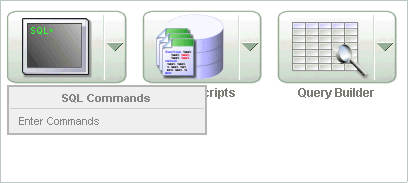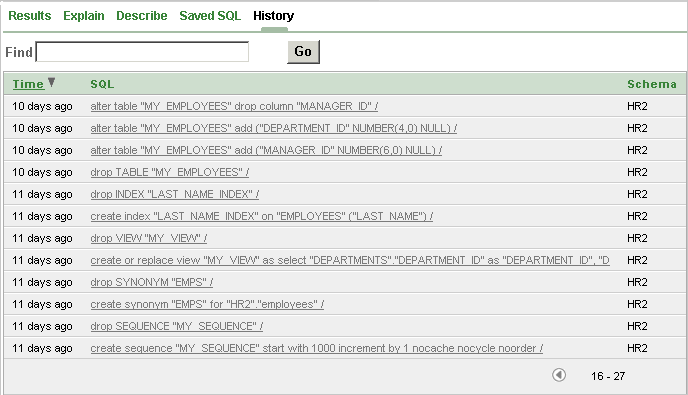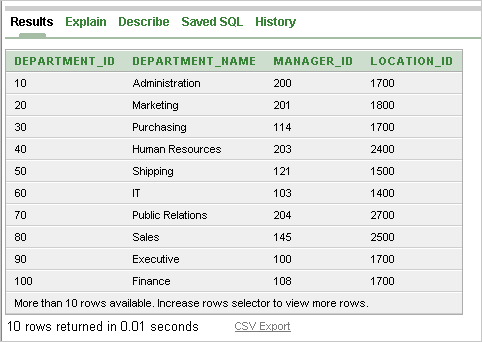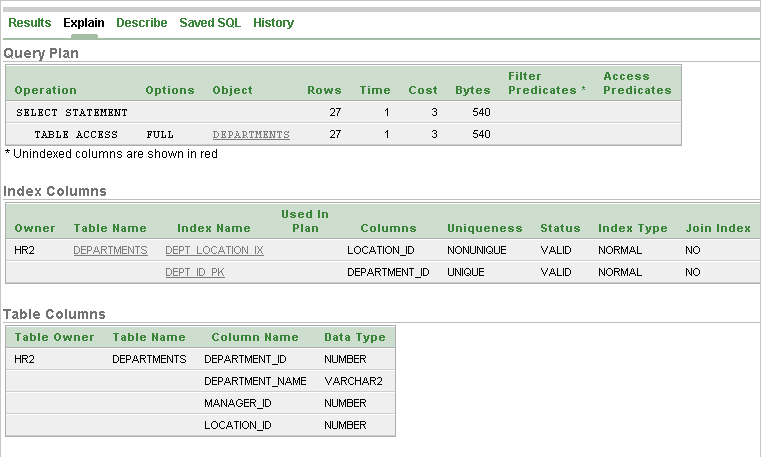| Oracle® Database Express Edition Application Express User's Guide Release 2.1 Part Number B25309-01 |
|
|
View PDF |
| Oracle® Database Express Edition Application Express User's Guide Release 2.1 Part Number B25309-01 |
|
|
View PDF |
This section provides information on how to use SQL Commands within Oracle Database Express Edition (Oracle Database XE) to create, edit, view, run, and delete SQL commands.
This section contains the following topics:
See Also:
"Using SQL" in Oracle Database Express Edition 2 Day Developer GuideYou can use SQL Commands to create, edit, view, run, and delete SQL commands. A SQL command can contain SQL statements or PL/SQL blocks.
When using SQL Commands, remember the following:
SQL commands created in the Query Builder can be accessed in SQL Commands.
Saved SQL commands must have names unique within a given database user account.
There is no interaction between SQL Commands and SQL Scripts.
You can cut and paste a SQL command from SQL Commands to run in the SQL Script Editor.
See Also:
"Using SQL Scripts"To access SQL Commands:
Log in to the Database Home Page.
The Database Home Page appears.
To view the SQL Commands home page you can either:
Click the SQL icon and then the SQL Commands icon to drill-down to the SQL Commands home page.
Click the down arrow on the right side of the SQL icon to view a drop down menu. Then select the SQL Commands menu option.

Note:
For the purposes of consistency, this document uses the primary navigation path (or drill-down approach) when explaining navigation.The SQL Commands home page contains a command editor and a display pane. You enter and edit SQL commands in the editor and view output, saved command lists, and history lists in the display pane.

On the SQL Commands home page you can:
Disable transactional commands. If available, click the Autocommit check box to enable autocommit and disable transactional commands. See "About Transactions in SQL Commands".
Set the number of output rows. Make a selection from the Display list to specify the number of rows of output to display at one time up to a maximum of 100,000. All rows of DBMS Output are displayed regardless of the Display list setting.
Save a SQL command. Click Save to save the contents of the editor, or the currently highlighted content to a file. You are prompted to enter a name and an optional description. The new command appears in the Saved SQL list.
Execute a SQL command. Click Run (or press Ctrl+Enter) to run the command in the editor, or the currently highlighted command in the editor.
Highlight an individual statement for execution. Select an individual statement in the editor and click Run (or press Ctrl+Enter) to execute only the highlighted statement.
The bottom of the SQL Commands home page features five tabs:
Results. Click the Results tab to see the results from the last successfully executed SQL command. Click DBMS Output at the bottom of the displayed results to display lines of DBMS output. This control only appears when there is DBMS output to display. Click CSV Export to export results to a comma separated file on your local file system. See "Viewing Results".
Explain. Click the Explain tab to examine the execution plan used by the optimizer for statements that make changes to the database. Objects in the output are linked to the Object Browser. Click the linked object to view its properties in the Object Browser. See "Using Explain Plan".
Describe. Enter Describe object_name and click Run to display column definitions for a table or view, or specifications for a function or procedure in the Describe tab. Select links in the Describe results to write that information into the command editor. For example, click a table name to add owner.table, click a column name to add the column name, click a procedure or function name to add the object call with parameters, or click a package name to add the package call.
Saved SQL. Click the Saved SQL tab to display a list of all SQL commands saved in the current database user account. Click the command title to load it into the command editor. See "Using Saved Commands"
History. Click the History tab to list your recently executed commands. Your last 200 executed commands are saved. See "Using SQL Command History".
You use SQL Commands to execute SQL commands within Oracle Database XE.
Topics in this section include:
To execute a SQL Command:
On the Database Home Page, click the SQL icon.
Click the SQL Commands icon.
Enter the SQL command you want to run in the SQL editor pane.
Click Run (Ctrl+Enter) to execute the command.
The results appear in the Results pane.
See Also:
"Viewing Results"To disable transactional SQL commands in SQL Commands, check the Autocommit check box. Attempting to use any transactional SQL commands such as COMMIT or ROLLBACK when transactional mode is disabled returns an error message.
To enable transactional SQL commands, clear the Autocommit check box. Oracle Application Express verifies that the necessary system resources are available before entering the transactional mode. If resources are unavailable, an error message is displayed.
Transactional mode is a stateful transaction mode where you can, for example, perform an update, select data for review, and COMMIT or ROLLBACK changes. It is implemented using DBMS_JOBS.
Consider the following behavior in transactional mode:
Actions are not committed to the database until you enter an explicit COMMIT command.
Exiting SQL Commands terminates and rolls back the current transaction.
A session time out terminates and rolls back the current transaction. The system preference, SQL_COMMAND_MAX_INACTIVITY, sets the time before an inactive session times out. The default timeout is 60 minutes.
The CSV Export option is not available.
SQL Commands does not support SQL Command Line (SQL*Plus) commands. If you attempt to enter a SQL Command Line command such as SET ECHO or DEFINE in SQL Commands, an error message displays.
You can terminate a command in SQL Commands using a semicolon (;), a forward slash (/), or with nothing. Consider the following valid alternatives:
SELECT * from emp;
SELECT * from emp
/
SELECT * from emp
The first example demonstrates the use of a semicolon (;), the second example demonstrates the use of forward slash (/), and the final example demonstrates a command with no termination.
You can save commands you enter in SQL Commands.
To save a SQL command:
On the Database Home Page, click the SQL icon.
Click the SQL Commands icon.
Enter the command in the command editor.
Click Save to save the command.
You are prompted to enter a name and description for the command.
Click Save, or click Cancel to return to the command editor without saving.
The saved command is listed in the display area.
To copy a SQL command:
On the Database Home Page, click the SQL icon.
Click the SQL Commands icon.
Click the Saved SQL tab, located between the command editor and the display pane.
The Saved SQL list of commands appears in the display pane.
Click the title of the command to load it into the command editor
Click Save to save the command.
Enter a new name for the command in the Name field and click Save.
The command is copied to the new name.
You can access the commands you save and commands saved by other users in the same database user account. You can also access SQL commands you and other users of the same database user account saved from the Query Builder.
Topics in this section include:
To access saved SQL commands:
On the Database Home Page, click the SQL icon.
Click the SQL Commands icon.
Click the Saved SQL tab which is located between the command editor and the display pane.
The Saved SQL list of commands appears in the display pane.
Click the title of the command to load it into the command editor.
The command appears in the editor.
Click Run to execute the command.
The Saved SQL pane displays a list of all commands saved under the current database user account. The list displays commands saved from SQL Commands and SQL commands saved from the Query Builder. Saved SQL commands must have unique names in the current database user account. The same name cannot be used in the Query Builder and SQL Commands.
Each command entry shows the owner name, the command name, the first characters of the SQL command, a description if it exists, who last updated the command and when.

On the Saved SQL pane you can:
Show commands by owner. Make a selection from the Owner list to specify the user whose commands you want to display. To view all scripts select -All Users-.
Search for a command. Enter a command name or partial name, or enter a code snippet in the Find field and click Go. To view all scripts, leave the Find field blank and click Go. You control how many rows display by making a selection from the Rows list.
Set the Number of Output Rows. Make a selection from the Display list to specify the number of Saved SQL commands to display at one time.
Delete a command. Click the check box associated with each command you want to delete, and click Delete Checked.
Sort commands. Click a column heading to sort the listed commands by that column.
Commands you have executed are stored in the command history regardless of whether you explicitly save them. You use SQL Command History to access commands you have executed in SQL Commands.
Topics in this section include:
To access history commands:
On the Database Home Page, click the SQL icon.
Click the SQL Commands icon.
Click the History tab, located between the command editor and the display pane.
The list of commands in History appears in the display pane.
Click the partial command displayed in the SQL column.
The command appears in the editor.
The History pane displays a list of commands you have executed.

Each history entry shows the time the command was last executed, the first characters of the command, and the schema in which it was executed.
On the History pane you can:
Load a command. Click the partial command displayed in the SQL column to load the command into the command editor. When the command loads, it also sets the schema in which it was last executed.
Sort by time. Click the Time column heading to sort the command history by least recent or most recent.
When you execute a SQL command, the results are displayed. The results of the last executed command are available until you execute another SQL command, or leave SQL Commands.
Topics in this section include:
To display SQL command results:
On the Database Home Page, click the SQL icon.
Click the SQL Commands icon.
Click the Results tab, located between the command editor and the display pane.

The HTML formatted results appear in the display pane.
Click DBMS Output to display plain text DBMS output results.
The DBMS Output control only appears if there is DBMS output in addition to HTML formatted results. It does not appear if there is only DBMS output, or if there is only HTML formatted output.
The Results pane displays SQL command results as HTML formatted table. The number of rows returned appears at the end of the output, and the time taken. DBMS output appears as plain text after the HTML formatted results.
On the Results pane you can:
Display DBMS output. Click DBMS Output at the bottom of the displayed results to display lines of DBMS output. This control only appears when there is DBMS output to display.
Export results. Click CSV Export to export results to a comma separated file on your local file system. You are prompted to enter a name and directory for the file.
You can view the explain plan the Oracle Optimizer uses to run your SQL command. You do not need to execute the command to view the explain plan.

Topics in this section include:
To view the Explain Plan:
On the Database Home Page, click the SQL icon.
Click the SQL Commands icon.
Enter or load the command whose plan you want to view.
Click Explain which is located between the command editor and the display pane.
The explain plan used by the optimizer appears in the display pane.
The Explain Plan pane shows the plan used by the Oracle Optimizer to run your SQL command. It typically displays the Query Plan, Index Columns and Table Columns used.
On the Explain Plan pane you can:
View object definitions. Click the object name in Query Plan to display the object definition in the Object Browser.
View index definitions. Click the index name in Table Columns to display the index definition in the Object Browser.